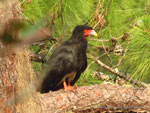BOISE, Idaho – For the first time in more than 50 years, researchers have found a nest of one of Central America’s rarest birds of prey, raising hope that there is still time to prevent its extinction in this region.
For unknown reasons, populations of the once-common Red-throated Caracara (Ibycter americanus) have crashed in Mexico and Central America, according to the Honduran Conservation Coalition, which made the discovery.
The nest was found in Honduras, deep in the pine forests of the northeastern province of Olancho. In February and March, local conservationist Isidro Zuniga located and tracked three small groups of caracaras across some of the most remote terrain in Honduras, according to Mark Bonta, a geographer at Penn State-Altoona and leader of the research team. Every day for six weeks, Zuniga sat in a blind and recorded the daily activities of a caracara family that raised a single chick.
The project was funded in part by The Peregrine Fund. Collaborators included biologist David Anderson of The Peregrine Fund and ornithologist Ruth Bennett of Cornell University, as well as Honduran biologists Luis Herrera of Panthera and David Medina of Partners in Flight. Additional support was provided by the Honduran Institute of Forest Conservation.
“This is huge,” Anderson said. “It’s like thinking that Bald Eagles are extinct and then rediscovering them in the mountains in your state.”
The Red-throated Caracara is still common in parts of South America, but until recently was believed to be gone from its former range north of Panama.
“The challenge for scientists and conservationists is figuring out what has caused the species’ precipitous decline and how to save it,” Bonta said. “If a pathogen is at fault, then even the South American birds may not be safe.”
The Red-throated Caracara feeds nearly exclusively on wasp larvae. The bird has a distinctive, raucous call and often moves in noisy groups of related family members.
Bonta said the recent decline is not a simple case of habitat loss because pine forests, which cover half of Honduras, have persisted despite thousands of years of human impacts like logging and burning. Also, people do not often shoot and kill this species, unlike other birds of prey, he added.
Bonta estimated that perhaps 25 family groups remain in northern Olancho, a sparsely populated region of Honduras. He said the 4,000-square-mile area, which is threatened by strip mining, includes dry forest, pine forest, and cloud forest ecosystems and the spectacular Sierra de Agalta, La Muralla, and Botaderos national parks.
“The Honduran Conservation Coalition and its partners hope that confirmation of the caracara’s nest will lead to concrete actions on the part of the Honduran government to protect still-virgin areas of pine forest in a corner of Central America dominated by extremely biodiverse but highly threatened habitat,” Bonta said.
For more information visit the Honduran Conservation Coalition
For more information, contact:
Erin Katzner
Director of Global Engagement
Main Phone: 208-362-3716
Direct Phone: 208-362-8277







